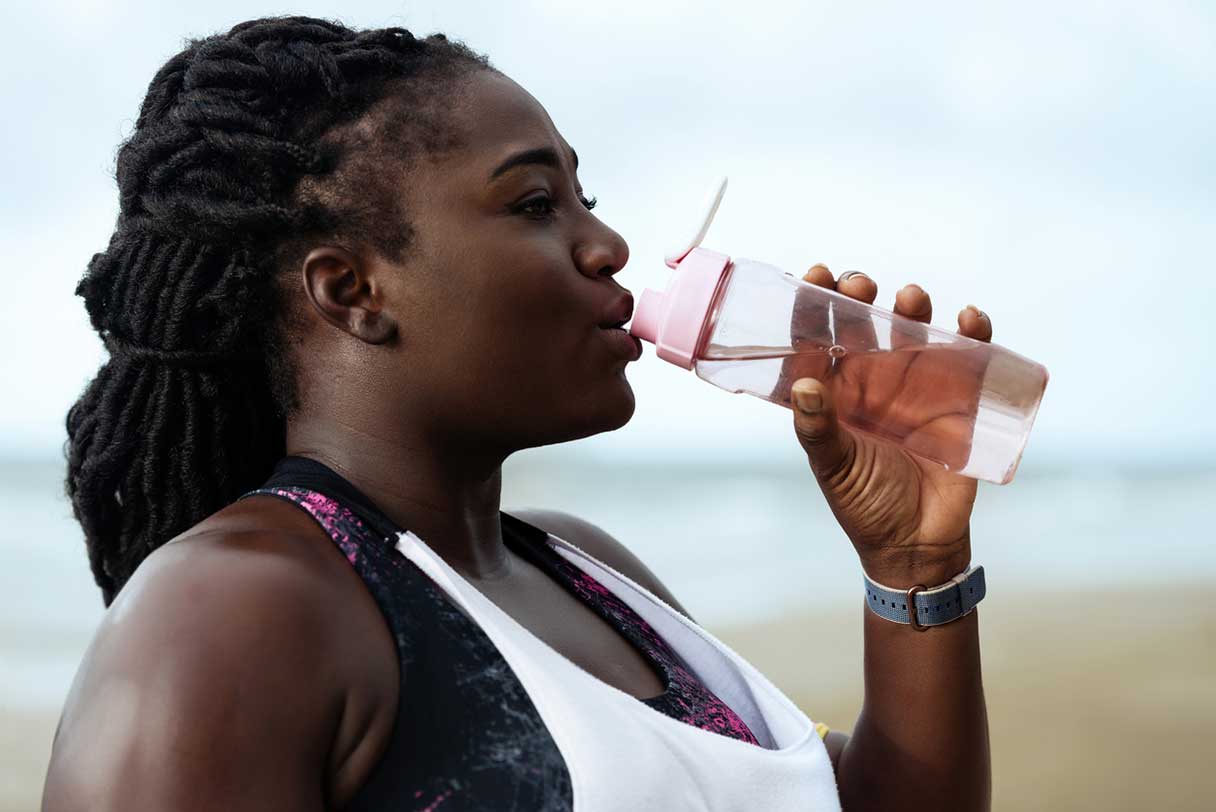If diet and exercise haven’t quite smoothed out those stubborn problem areas, you’re not alone — and there may be other options. You may want to consider turning to non-invasive fat removal treatments to help refine your contours without surgery.
According to the latest Plastic Surgery Statistics report, treatments like CoolSculpting®, Liposonix® and Emsculpt® are among the top 10 non-invasive cosmetic procedures.1
Non-invasive fat removal is a broad category of non-surgical treatments designed to address stubborn pockets of fat with limited downtime. Read on to learn more about some of these treatment types.
What Is Non-Surgical Fat Removal?
Non-surgical fat removal treatments utilize one (or more) of the following techniques to target and reduce localized fat cells without any incisions to the skin:2
- Cold
- Heat
- Injections
- Laser
- Red light
- Ultrasound
Determining which procedure is right for you may depend on the treatment area, number of treatments needed, comfort level and overall treatment cost. Here are 11 non-invasive fat removal procedures to consider.
1. Fat Freezing
Fat freezing treatments, also known as cryolipolysis, apply extreme cold to fat cells. Fat cells are more sensitive to cold than other types of cells, allowing them to be targeted and destroyed while the skin and surrounding tissues remain unharmed.3
How it works
Fat freezing treatments, such as CoolSculpting, place an appropriately sized device on the skin. Gentle vacuum suction pulls the skin and fat pocket into the applicator, where extreme cold is applied to the area, numbing it while it begins freezing unwanted fat cells. As the frozen fat cells die, they are naturally eliminated over time and permanently removed by the body.3
Fat freezing is best suited for areas such as the thighs, abdomen, flanks and arms.4 Each treatment can take 35 to 60 minutes.2
Results
Over the weeks following the treatment, the destroyed fat cells are eliminated from the body. Although some areas may require multiple treatments to achieve desired results, the average fat reduction is about 20% to 25%. Low complication rates and no downtime make fat freezing treatments one of the most popular non-invasive fat removal procedures.4
Costs
The national average cost* for a CoolSculpting fat freezing treatment is $1,723, but the cost ranges between $1,432 and $5,008, depending on the treatment area, number of treatments and your geographic region.5
2. Laser Fat Removal
Laser fat removal treatments, such as SculpSure®, use focused laser energy to heat, break down and permanently destroy unwanted fat cells.4
How it works
During a laser fat removal treatment, laser applicators are applied to the area to provide targeted heat. A simultaneous cooling mechanism in the device ensures that the surrounding skin is not damaged. Treatments take about 25 minutes per area.2
Laser fat removal is FDA-approved for use on the abdomen, thighs, back, love handles and under the chin.6
Results
Results are visible at about six weeks, with final results in 12 weeks. Barring additional weight gain, the results from laser fat removal are considered permanent.2
Costs
Laser fat removal treatments like SculpSure can range from $300 to $1,500 per session, depending on the location and size of the treatment area.6
3. Radiofrequency Treatments
Radiofrequency fat reduction treatments like Vanquish®, also known as radiofrequency lipolysis, use magnetic waves to heat and melt away fat cells without actually touching the skin.7
How it works
Unlike other non-invasive fat reduction treatments that require direct contact with the skin, the radiofrequency applicator targets and heats the fat cells from 1 centimeter away. This method can also treat larger body parts compared to other non-invasive options. Radiofrequency fat reduction treatments usually take about 30 minutes, and multiple sessions may be required.7
Results
Multiple sessions spaced once or twice a week may be needed to achieve desired results, with patients typically seeing a gradual 15% to 20% reduction in body fat.4
Costs
The cost for Vanquish fat reduction can range from $500 for a single session for one zone and up to $4,000 for multiple sessions treating multiple zones.8
4. Injectables
Injection treatments like Kybella® are another popular non-invasive fat removal procedure to address localized pockets of fat often underneath the chin.2
How it works
Injectables like Kybella use deoxycholic acid to break down and dissolve fat, providing localized submental fat reduction. Once a topical anesthetic is applied, the injections are administered into the skin in a grid pattern, with the entire treatment usually taking about 20 minutes.2
Results
Fat reduction injections often require multiple treatments for patients to achieve their desired results. Fat reduction in the area is considered permanent.2
Costs
The national average cost* for a Kybella injection treatment is $640 per vial, but the cost ranges between $492 and $1,150.9
5. Ultrasound Fat Reduction Therapy
Ultrasound fat reduction therapy, also known as ultrasonic cavitation, uses focused sonic waves to break down fat cell walls, releasing the fat to be metabolized by the body and eliminated. UltraShape® and Liposonix are two versions of ultrasound fat reduction treatments.2
How it works
The ultrasound treatment is delivered to the desired area. The specific frequency of the ultrasound waves doesn’t impact the surrounding tissue, so there’s no bruising or swelling following the procedure. Ultrasound fat reduction therapy is designed to be used on the abdomen and love handles.2
Results
Typically, one to three treatments spaced two weeks apart deliver the best results. Initial results are gradual, with final results visible within six to 12 weeks.2 Patients may see a 15% to 20% fat reduction in the treated areas per session.4
Costs
Although geographic region and number of treatments will influence the total cost, treatment sessions for ultrasound fat reduction therapy like Liposonix can range from $1,500 to $3,000.10
6. Red Light Therapy
Red light therapy for weight loss, such as UltraSlim®, delivers wavelengths of light that shrink the volume of subcutaneous fat cells in an area, targeting and reducing stubborn pockets of fat.2
How it works
For this treatment, red light panels will be positioned over the treatment area. Unlike other treatments that aim to destroy fat cells, red light therapy triggers the fat cells to reduce their contents, reducing the amount of fat held in each cell. The body then metabolizes and eliminates the fat. Red light fat reduction therapy is designed to treat the abdomen, hips and thighs with treatments taking about 30 minutes per session.2
Results
Results may appear within a few hours after treatment and will continue to improve as the body metabolizes the fat. Most patients choose three or more treatments to achieve their desired final results.2
Costs
A single session of red light therapy for fat loss may cost between $1,500 and $3,000, depending on your geographic location, the provider’s experience and the area of the body that’s being treated.11
7. Laser Liposuction
Laser liposuction, also known as laser lipolysis, is a fat reduction procedure that uses a laser to target, melt and remove fat cells. However, the procedure does require small incisions and is therefore not truly a non-invasive procedure.12
How it works
During laser liposuction treatments, a thin tube is inserted under the skin to direct the laser’s energy into the treatment area and suction out the melted fat. Laser lipo does require local anesthesia and small incisions, but it offers a much faster recovery time than traditional liposuction — often just a few days.12
Results
Although a few days of swelling and bruising are normal after the procedure, many individuals see an immediate reduction in fat after their first treatment. Final results from laser lipo may take up to four weeks. Laser lipo also works to tighten the skin by stimulating collagen production in the area, helping to reduce the risk of loose skin after the procedure.12
Costs
The cost of laser lipo can vary based on the number of sessions, your geographic location and treatment area. On average, laser liposuction can cost $2,500 to $4,500 per area, with combination areas like the upper and lower abdomen costing as much as $9,000.12
8. ThermaLipo
ThermaLipo is a combination treatment that uses heat and laser liposuction to help reduce fat and tighten skin, creating a smooth, contoured appearance. Because it uses laser liposuction, the procedure is not entirely non-invasive, but a local anesthetic will help you remain comfortable.13
How it works
ThermaLipo begins by numbing the treatment area and then inserting a small tube under the skin to melt and suction out pockets of fat. Afterwards, heat is applied to the same area to tone and tighten the skin. This treatment is ideal for areas of the body where you’d like to see both fat removal and skin tightening.14
Results
Some get closer to the smooth and contoured body you want after just one session. Others may need two or three treatments to get the results they want.13
Costs
Depending on your geographic location and treatment areas, the average cost of Thermalipo can typically range between $2,500 and $5,000.13
9. Emsculpt Neo
Another combination fat reduction treatment is Emsculpt Neo, which combines muscle stimulation and radiofrequency to melt away fat while also toning muscle and tightening skin.15
How it works
Completely non-invasive, Emsculpt Neo is the only non-invasive fat removal option that can treat fat, muscle and skin simultaneously. During the treatment, applicators on the treatment area will make the muscles in the area contract while, simultaneously, radiofrequency energy will target fat and tighten the skin.15
Results
Each session takes about 30 minutes, and many people start with four sessions spaced two to three days apart.15
Costs
Emsculpt sessions typically range from $750 to $2,000 each, meaning a full treatment plan could cost between $1,500 and $6,000, depending on your geographic location and treatment area.16
10. Mesotherapy
Mesotherapy is a minimally invasive injection treatment to target and break down small pockets of fat. This technique is often used on the chin, arms, abdomen or thighs and may be combined with other fat reduction treatments such as ultrasound therapy for improved results.17
How it works
Mesotherapy involves injecting a blend of substances, such as plant extracts, vitamins and saline, into the middle layer of the skin to target fat and improve skin tone. Ingredients in the injection break down fat cells and stimulate collagen production. Mesotherapy can be used to treat the abdomen, flank, arms, chin, thighs and arms. Multiple treatments spaced four to six weeks apart are usually required to see desired results.17
Results
Post-procedure bruising, swelling and tenderness are common but temporary. Fat reduction results can vary based on treatment area and number of treatments.17
Costs
The average cost of mesotherapy fat reduction is $250 to $600 per session.18
11. Carboxytherapy
Carboxytherapy is a non-invasive fat reduction treatment that involves injecting carbon dioxide gas under the skin to improve its appearance and reduce stubborn fat.19
How it works
During a carboxytherapy treatment, a thin needle will be inserted under the skin of the treatment area to administer a small amount of carbon dioxide gas. The presence of the gas causes the body to increase blood flow and oxygenation to the area, breaking down fat cells and helping to smooth dimpled skin. Carboxytherapy can be used on the thighs, abdomen, arms and buttocks with treatments lasting 15 to 30 minutes.19
Results
On average, patients will need eight to 10 sessions, with some stubborn areas requiring additional sessions. Carboxytherapy has been found to be an effective treatment for fat reduction while also improving skin elasticity.19
Costs
A single session of carboxytherapy fat reduction therapy can cost between $90 and $290, depending on the treatment area and geographic location.19
Should You Consider Non-Invasive Fat Removal?
To determine if you’re a good candidate for a non-invasive fat removal procedure or treatment, start by consulting with a board-certified cosmetic surgeon who is experienced in performing these procedures. While the right treatment depends on your desired results, budget and time frame, those close to their ideal weight are most likely to benefit from the results of non-surgical fat removal procedures.
Patients who are significantly overweight may want to consider a more invasive cosmetic procedure — such as liposuction or weight loss surgery — to achieve their desired results.
Financing Non-Surgical Fat Removal With the CareCredit Credit Card
When getting non-surgical fat removal or another cosmetic procedure, the CareCredit credit card can help you pay for costs not covered by insurance.** Use our Acceptance Locator to find a doctor or cosmetic specialist near you that accepts CareCredit. Continue your wellness journey by downloading the CareCredit Mobile App to manage your CareCredit account, find a provider on the go and easily access the Well U blog for more great articles, podcasts and videos.
In addition to cosmetic procedures, you can also use your CareCredit credit card for dentistry, pet care, vision, hearing, health systems, dermatology, pharmacy purchases, spa treatments and so much more within the CareCredit network. How will you invest in your health and wellness next?
Author Bio
Kate Bayless is a health and wellness freelance writer with 20 years of experience. Her work has appeared in Parents, Women’s Health, Beachbody and OpenFit.







